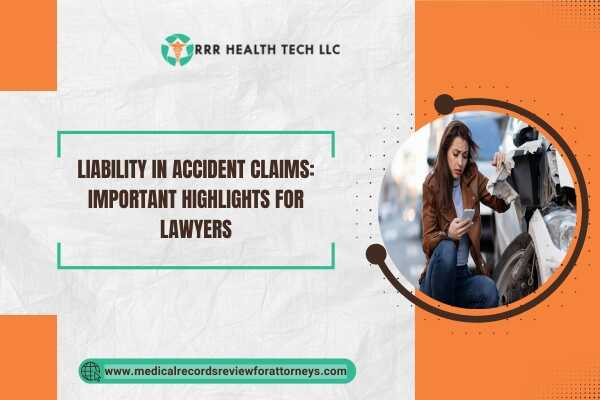
Accident claims are seldom any easy matters. Most claims intertwine multiple factors of liability. For attorneys working with a client suffering an injury in an accident claim, it is important to know how liability is allocated. This document explains the types of liability in accident claims within the context of negligence, determining fault, and how a case is built through medical record reviews.
Categories of Liability Accidents Claims
1. Negligence
· Definition: Negligence occurs when a party fails to exercise reasonable care, resulting in harm to another person.
· Examples: Car accidents due to distracted driving, slip and fall incidents due to inadequate maintenance.
2. Strict Liability
· Definition: Under strict liability, a party can be held responsible for damages without proof of negligence or fault.
· Examples: Defective product cases, certain animal attack cases.
3. Vicarious Liability
· Definition: This legal doctrine holds an employer or principal liable for the negligent actions of an employee or agent while performing their duties.
· Examples: A delivery driver causing an accident while on the job.
4. Comparative and Contributory Negligence
· Comparative Negligence: In jurisdictions that follow this rule, a plaintiff’s compensation may be reduced by their percentage of fault in the accident.
· Contributory Negligence: In some states, if a plaintiff is found to be even slightly at fault, they may be barred from recovering any damages.
Assigning Responsibility in Incident and Accident Cases
The Steps to Assigning Responsibility
- Gathering Stand-Alone Evidence: Collecting evidence from the site that, on its own, signifies more than hypothetical police reports such as eye witness accounts or photograph.
- Systematically describing all relevant evidence: This involves evaluating all evidence collected in the previous step and ordering it chronologically to identify the perpetrators and victims.
- Testifying: This step is going to talk to people who specialize what goes on into a vehicle accident / people who put together pictures and create models of the events after which the put the pieces together to award the model to risk the accident.
Factors That Change -Fault Relationship -Responsible For All Violations of -Registering Eye Account
-Physical Evidence: Evidence of police and personnel insignia, pace paths, emblems off vehicles, emergency motion marks, their movement the off and from roads, burnt territory, roads including territory out of them.
Role of Reviewing Medical Documents
How Medical Records Should Relate to Accidents
· Evidence of Injury: Medical records document the extent and nature of injuries sustained in an accident, which is crucial for establishing damages.
· Causation: They help demonstrate the link between the accident and the injuries, supporting the plaintiff’s claims.
Conducting a Medical Record Review
• Gather all relevant medical documents pertinent to the incident.
• Scrutinize the injured party’s records to check whether or not there is a deviation from the claim made.
• Seek the assistance of other medical specialists to explain the results and give professional opinion where necessary.
Case Studies
Case Study 1: Rear-End Collision
Overview of the Case: An individual was rear-ended at stoplight and suffered notable injuries.
Challenges: The plaintiff was accused by the defendant of coming to an abrupt stop, which contributed to the incident.
Solutions: Medical records evidencing the injuries and traffic camera footage proving the defendant’s velocity during the impact corroborated his testimony.
Case Study 2: Slip and Fall Incident
Overview of the Case: One of the customers slipped and fell in the grocery store due to a wet floor and no caution sign placed to alert them.
Challenges: The store countered that the customer was inattentive.
Solutions: Supplementary medical documentation supported the claim of injury and eyewitness accounts validated the absence of warning signs.
Conclusion
An attorney who represents clients suffering from personal injuries must understand how liability works in accident claims. Reviewing the types of liability, reviewing the steps of the blame allocation process, assessing where the dispute falls in the system of medical records, and the medical imaging provided gives comprehensive understanding vital to strengthening the case which lawyers have to manage on behalf of their patients.
